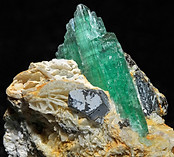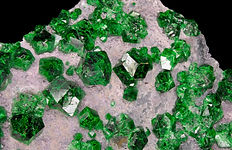top of page
May Birth Stone:
EMERALD

One of the precious “four”; the stone that celebrates the 20th and 35th wedding anniversaries; the stone for people born in May or under the Cancer sign; emeralds have been attractive since the Antiquity.
The word “emerald” comes from the Greek “smaragdos” which means “green gems” through Latin and Old French. Emeralds are part of the “Gem Royalty” along with Rubies, Sapphires and Diamonds. As such, emeralds’ qualities are ruled by the “4 Cs” (Colour / Cut / Clarity / Carat), colour being the most important feature when choosing a stone before its clarity. The high degree of transparency is to be taken into account for top gems.
Dark green emeralds are considered to be the most beautiful ones because of their rarity. Emerald hues vary from yellow-green to blue-green with medium to dark tones. Light-toned gems are usually known as “green beryl”, which essentially is really what an emerald is, beryl coloured green by traces of chromium and sometimes vanadium.
Emeralds are not particularly tough and finding stones without a surface broken with fissures is extremely unlikely. That is why emeralds have to be treated with oil, Cedar Oil being the most used by jewellers, to toughen them and enhance their apparent clarity. “Jardin Emeralds” (from the French: “Garden Emeralds”) are stones whose lack of uniformity gives them a “mossy” look created by the fissures and the inclusions within the gems.
That poor toughness also explains why Emeralds are rather cut into cabochons form than faceted shapes even though emeralds gave its name to a jewellery cut for gems: an “emerald cut” is a rectangular cut with facets and top edges.
Therefore one should take special care of emerald jewellery because the gem is more fragile than any other forms of beryl. A good and effective way to protect it is to have it wrapped in soft cloth and inside a box. That way you will avoid any scratch that could occur when touching another piece of jewellery for instance.
“Cleopatra’s mines” in Egypt produces the majority of Antiquity’s emeralds until the discovery of the green gem in India and Austria in the 14th century but most importantly in Colombia. Still today Columbian mines provides between 50 and 95% of the world production. Colombia is also famed for the rare dark green emeralds, mined deep into the ground. The African state of Zambia is the second world producer for emeralds but they have been found all over the world, from Australia to France even.
In the US, vanadium-bearing beryl are sold as emeralds since the 1960s but are not recognised as such in Europe. The difference is made using the term “Colombian emerald”, a true emerald to European standards. Synthetic emeralds are also produced since 1848 and the process became excellent in the 1950s with a higher quality of lab-made stones.
Anyway the green gem has fascinated people all over the world, especially specimens such as the Bahia Emerald, The Chalk Emerald or the Gachalà Emerald. The Queen of England owns a beautiful set of emerald jewellery: the Cambridge and Delhi Dunbar Parure, including a magnificent tiara. Another Elizabeth, Elizabeth Taylor, marvelled at the stone, after husband Richard Burton at the time, offered her an emerald and diamond brooch … followed by a necklace, a pair of earrings, a bracelet and finally a ring.
Emeralds have also entertained through literature and cinema. La Esmeralda, the gypsy heroine from Notre-Dame de Paris (The Hunchback of Notre-Dame) written by French Author Victor Hugo in 1931, was named after the jewel around her neck, an emerald stone.
Centuries later Michael Douglas and Kathleen Turner will follow the trail of an amazing but bloody Colombian Emerald in Romancing the Stone in 1988. The very word “emerald” is nowadays a synonym for the incomparable green hue that can be identified anywhere … No surprise then that Ireland should be nicknamed “the Emerald Isle”…
Even though emerald jewellery can be found at a relative affordable price, you may consider other substitutes such as green aventurine quartz, demantoid garnet, tsavorite, chrome tourmaline, grossalurite garnet, verdelite, fluorite, diopside, uvarovite, hiddenite or even peridot. A long list of beautiful green stone but that won’t – as the Hindu Holy Scriptures believe – bring good luck and well-being to the people born in May under the vibrant colour of emeralds.
































bottom of page






